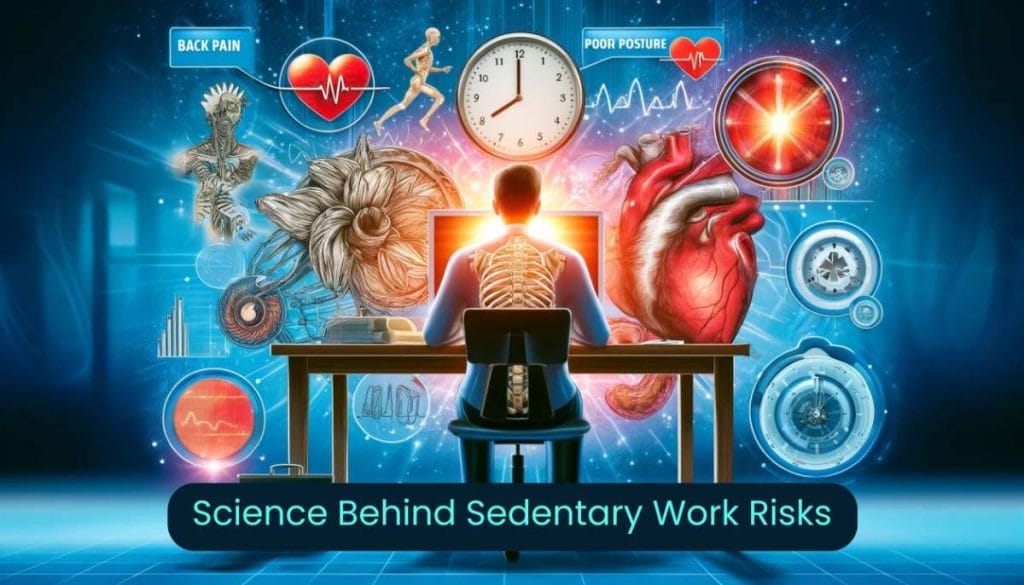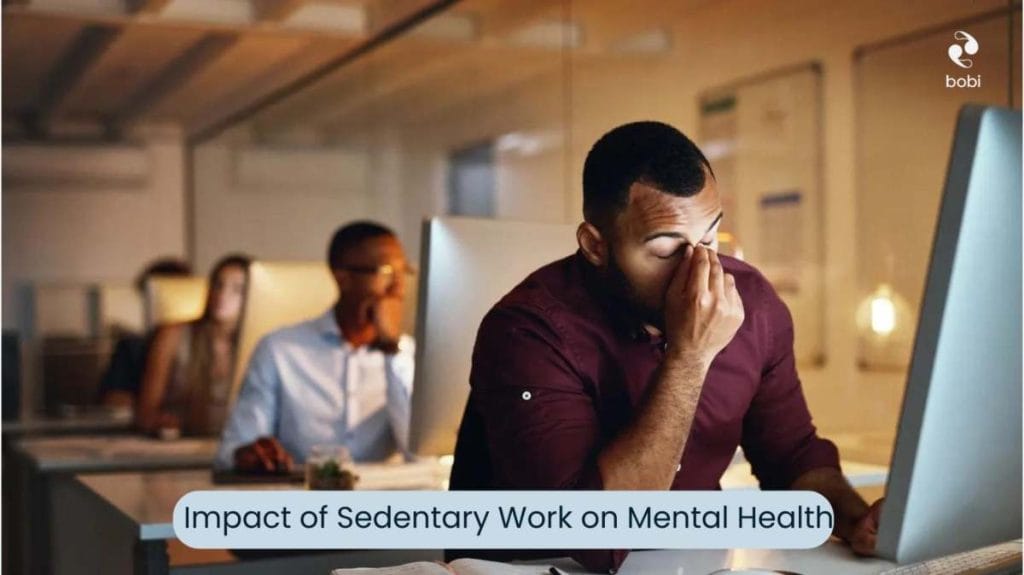
Of the whole global population, one-third aged 15 years and older are involved in inadequate physical movement, which impacts health. Work habits have strikingly changed in the last few decades leading to sedentary work risks. With the growth of technology, more people have jobs that require prolonged sitting. The term, “sedentary work” may sound technical, but it just refers to jobs that require a long duration of sitting or minimum physical activity.
But do you know that spending most of your workday sitting can lead to serious health risks? It may appear unbelievable but sedentary work risks cause hypertension, obesity, heart disease, mental health issues, and even lower life anticipation. In this blog post, we will disclose the specifics behind these risks, examining why a sedentary lifestyle is new a smoking, and the role of physical activity in counteracting these risks.
Sedentary work means spending a lot of time sitting down. This has become common in many jobs today. Health experts are worried because sitting too much can lead to health issues. Without noticing it, you might be falling into a gradually sedentary lifestyle.
The professions with minimal or no movement at all of the bodies are referred to as “sedentary work”, described as longer durations of sitting, and low energy consumption levels, just like the energy consumption people have at rest. This usually happens at a desk or workstation.
People in these jobs don’t move much, often just walking or standing a little. Such occupations are generally, remote work, office-based jobs, or any positions that demand a person to have a seat for extended periods.
Office workers, writers, programmers, and call center representatives are examples. If we take it from a health service angle, a sedentary attitude includes any activity that utilizes very minimum energy, like lying down, sitting, or even resting horizontally. It’s a very simple pattern to get in, but not without risks. This rise in sedentary jobs remains a significant health issue because it is linked to a higher chance of chronic diseases.
Studies have shown that the average daily period of sedentary behavior in the Korean population is 8.3 hours and among the American grown-up population is 7.7 hours. In Western society, workers have witnessed a significant transformation toward sedentary jobs over the past 50 years.
A study presented in the journal of BMC Public Health demonstrated that almost 60% of U.S. adults spend more than 6 hours in a day sitting. This means sedentary behavior is becoming the most widespread daily pursuit, even outdoing sleep in a few situations.
Manual and industrial jobs have notably reduced, as technology has pushed desk-based jobs. This is mainly due to technology, automation, and the growth of the knowledge economy.
As stated by the American Heart Association in a study, since 1950 sedentary jobs have raised 83%. Activity-driven jobs now account for less than 20% of the US employees, less than around half of the occupations in 1960.
What makes things worse is that the COVID-19 pandemic has only boosted this shift, as more people started working from home with minimal activity all over the workday. While this change may improve how well things get done, it also raises concerns about health risks from sitting for such long periods.
The human body is made to move and to stand up straight. When we stay inactive for a long time, it can harm our bodies differently. Working in a sedentary job disrupts how our body naturally functions. This makes people more likely to face health problems that affect their physical and mental health.
Many studies have shown a strong connection between prolonged sitting and a higher chance of developing long-term health problems. Yes, it’s quite dangerous stuff! Here are some health issues linked to a sedentary lifestyle.
These health risks highlight the importance of adding physical activity to our daily lives, even for those who mostly sit at work

The sedentary work risks go beyond just our bodies. Our mental health is also at risk.
Studies have shown a closer connection between sitting for longer durations and elevated probabilities of stress, anxiety, and depression. When physically functioning, the brain secretes serotonin, a mood-boosting substance in the brain.
With sedentary work, less serotonin and endorphins are secreted, so people will have minimal positive feelings and less motivation. With less motivation, regulating mental health becomes much more challenging.
“Prolonged sitting doesn’t just affect your body; it affects your brain,” says Dr. Jane Smith, a leading researcher in occupational health. “When you move, blood flow increases throughout your body, including the brain, which can improve mood, focus, and overall mental health.”
Moreover, people who sit a lot often feel less confident, have trouble sleeping, and notice a decline in their thinking skills. Adding regular physical activity to treatment plans can greatly reduce these risks and help improve mental health. Even brief moments of movement during the day can really help.
The good news is you do not need to make big changes to your lifestyle to fight the sedentary work risks. Studies show that even small amounts of exercise can help lower the negative effects of sitting for a long time. By adding movement to our daily lives, we can improve how our bodies work.
Regular exercise is the key to counteract the health risks of sedentary work. If you’re living a sedentary work life with minimum or no physical activity, it’s not too late to go from a bad to a good routine.
Here are a few strategies to integrate activity into your routine:
The World Health Organization endorses at most 150 minutes of average movement in a week for adults, as it can notably reduce the health issues caused by sedentary work.
An amazing and unexplored strategy to prevent the impacts of a sedentary attitude is via unilateral hand contractions. This means you squeeze and relax one hand at a time with a stress ball or grip strengthener.
Test results show that doing these contractions regularly, even while you sit, greatly boosts blood flow to your brain (known as cerebral blood flow). Importantly, these exercises are easy and don’t take much effort. You can fit them into your workday without a problem.
For example, you can squeeze a stress ball or hold light objects during breaks or meetings to feel the benefits.

The idea of unilateral hand contractions may look simple, but the science behind why they work is important. These small movements use muscles and encourage blood flow, which improves circulation in the body. This is especially useful for people who sit a lot at work. It helps fight reduced cerebral blood flow, in particular.
The benefits of rhythmically squeezing one hand are multifaceted.
Unilateral Hand contractions go just beyond activating blood circulation; they can improve brain functioning too. Research shows that these simple actions can help the brain work better.
When you squeeze, there is a discernible increase in blood flow to the brain. This brings extra oxygen and nutrients, which improve skills like focus, alertness, and memory.
Such hand movements stimulate certain brain areas linked with coordination and motor control. Rhythmic hand exercise while sitting holds considerable promise, especially for those who do hard mental work. The regular incorporation of these exercises into a routine can enhance cognitive activity, focus, and mental awareness.
Enhance your hand contraction routine by incorporating bobi _ an innovative personal coach. bobi can increase the advantages of these exercises by assisting users through intentional grip exercises and paced breathing.
Its tangible nature promotes mindful hand exercises, which improve calmness and offer a chance for concentrated activity that enhances mental health. Using “bobi” as part of a daily hand contraction routine can help deepen mental relaxation, improve focus, and further stimulate brain activity, making it a powerful tool for those aiming to reduce stress and increase alertness while seated.
Dr. Laura Williams, a clinical psychologist, said, “Simple hand movements like squeezing or gripping not only benefit physical health but also enhance brain activity. Such techniques are especially useful for individuals who spend most of their time sitting.”
Exercising does more than just help our bodies. It also helps release hormones that are critical to our health. These substances are known as “hope molecules” and they are predominately released from our skeletal muscles.
When we are involved in any exercise, our muscles contract and release chemicals (small proteins) known as hope molecules, scientifically called “myokines”. Physical activity helps release “hope molecules”, including brain-derived neurotropic factor (BDNF), which are known to support mood and cognition. This mood boost is why exercise is often seen as the first step to better mental health.
There are several advantages of these chemicals, including lowering inflammation, improving insulin sensitivity, and especially enhancing mental health.
This all adds to a strong sense of well-being. You don’t have to do hard workouts to gain these benefits. Even light activities can be helpful. Myokines are good at encouraging the discharge of “feel-good” substances such as serotonin and dopamine, that can reduce stress, depression, and anxiety.
Surprisingly, short pauses of activity like stretching, walking, or standing up for some minutes can activate the excretion of these precious molecules.
As noted, when muscles contract during physical activity, they release hormones called hope molecules (also known as myokines). These so-called hope molecules act as chemical messengers, positively influencing various bodily functions.
For instance, some myokines help regulate blood sugar levels, reducing the risk of type 2 diabetes. Others possess anti-inflammatory properties, offering protection against chronic diseases like heart disease and certain cancers.
Regular exercise, even if it’s just a brisk walk, can significantly boost the production of these beneficial myokines, effectively lowering your chances of developing these illnesses.
In conclusion, it is important to understand the sedentary work risks. Knowing how this can harm our health and adding exercise to our daily habits can help us deal with the problems of long periods of sitting. Unilateral hand contractions are a simple and great method to improve blood flow and boost mental focus. But investing in an innovative tool like bobi can double the benefits. Moving our bodies not only helps us avoid health issues but also supports our mental health. Let’s make our health a priority. We should break the habit of being inactive and embrace the science that shows the benefits of staying active.
Sedentary work means sitting for long periods with not much movement. This kind of lifestyle can raise health risks.
When you don’t move enough, it can cause different health problems. These can include musculoskeletal diseases heart disease, obesity, and issues related to mental health.
Unilateral hand contractions can help get more blood flowing. This may improve how well you can use your hands, even when sitting down. You can easily add this simple exercise to your daily routine and treatment plans. It can help reduce the bad effects of sitting for a long time. In turn, it could boost your overall health based on test results.
Yes, research shows that even small movements while sitting, like regular physical activity, can boost blood flow to the brain. This helps brain activity and improves mental health. When mental health is better, it can positively affect your work experience.
Stay updated on what's happening at bobi, and all things breathing, anxiety and mental wellness.